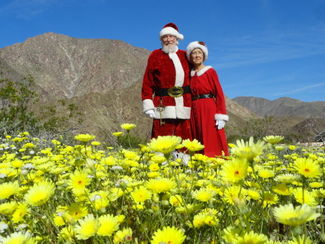Super Bloom Latest: Still Strong
Last updated 4/30/2019 at 11:03am
As the spring season settles in and warmer temperatures begin to slowly take over the valley, many are wondering how much longer the wildflowers will be putting on this show for us. How long will all the colors of yellow and green greet those coming down the Montezuma Valley Road, or the fields of flowers in Coyote Canyon and Hell Hole Canyon Road?
The bloom is still going strong, and we are now likely seeing plants in bloom that germinated from the mid-February rain, where a record setting 2.86" of rain fell. New areas are blooming, and different flowers are blossoming from the past couple of weeks.
"In many ways the bloom right now has a bigger 'wow' factor because it is so electric bright - with yellow being the main color of the moment, from yellow desert dandelions and poppies, and the accent color being the purple of phacelia," said the report on BorregoBlooms.org.
Compared to the Super Bloom in March 2017, nearly half an inch of rain fell this March, while there was nary a measurable drop two years ago.
Since October, we have had about eight and a half inches of rain at the Park Headquarter gauge (six inches is our historical average), with nearly half of that amount falling in February.
Warming temperatures from the high-70s to upper-80s will be with us till at least April 15, according to the AccuWeather forecast, also helping to possibly extend this year's Super Bloom.
Perhaps only a curiosity, the eastern slopes of the San Jacinto Mountains are, surprisingly, filled with green grasses from the valley floor all the way up to the ridge tops from Coyote Creek at the northern end to Yaqui Pass Road at the southern end. Thanks to the rains, this could be an indication that a spectacular eruption of flowers (at least in large patches) may be imminent along the slopes extending the entire length, about 20 miles. If any of our readers have seen or have knowledge of such a sight, please let us know in which century that occurred.

As of March 24, there are still localized areas with good blooms of desert annuals, but there are fewer of those areas than week or two ago, and that phase of the bloom is fading. The ocotillo's are now in full bloom in numerous places, and the hummingbirds are enjoying the nectar.
Desert indigo, as well as cacti, are blooming with the best places being the rocky outcrops and slopes that border the washes and canyons. Barrel cactus, fishhook cactus, beavertail cactus, and hedgehog cactus are blooming in the lower elevations of Borrego Springs. It is said the best all-around areas to see these are along the Yaqui Wells Trail across from the Tamarisk Grove Campground, and Glorietta Canyon.
Yellow Peppergrass fill Little Blair Valley (near mile marker 23), while the Box Canyon area has patches of Phacelia, which will catch your eye.
If one hasn't done so already, one of the very interesting things to be seen right now is the vast bloom of Dune Evening Primrose growing out of cracked dried mud patterns on Henderson County Road (site of 2017's "Super Bloom"). There are large swaths of purple sand verbena and white dune evening primrose, with a nice bloom of yellow desert sunflowers starting to develop. They are fragile as delicate glass and they will surely fall apart as people explore the area, but they make for beautiful photos if you can get there.
Down north on DiGiorgio Road in Borrego Springs, one will see fields of cheery yellow desert dandelions on private land. The dirt road extension into Lower Coyote Canyon is open to All-Wheel-Drive or 4WD vehicles only.
There is room for 2WD parking at the end of the pavement. Flower seekers should walk up the dirt road for a wide variety of flowers, or explore to the east for a field of desert sunflowers and sand verbena. One may also find lupine, brown-eyed evening primrose, and a few desert lilies. All are urged to respect private property adjacent to the flower fields, and stay out of the citrus orchards.
With all these beautiful flowers, they have also become a buffet for the caterpillars, who are having a feeding frenzy.
"The flowers were excellent, but then a huge batch of sphinx moth caterpillars came in and took entire fields of 100 acres or more at a time, and in a couple of days, wiped them out," Mark Jorgensen, former Superintendent of the Anza-Borrego Desert State Park said, in his recent interview with the San Diego Union-Tribune.
Jorgensen explained that the caterpillars descended on the valley a few weeks ago, and they started to mow through the new growth stripping them, and as many as 40 caterpillars on one plant.











